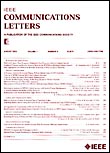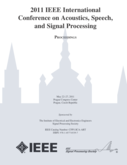Toeplitz and random matrices
The papers in this section deal either with (real or complex) matrices having Toeplitz structure, or with matrices with random entries over the binary field GF(2). The papers on Toeplitz matrices explore the similarity between Toeplitz and circulant structure in different ways. The papers on random matrices deal with the full rank probability and rank distribution of the matrices (including matrices with block-angular structure).
 Random binary matrices appear in a variety of signal
processing and encoding problems. They play an important role
in rateless codes and in distributed storage applications. This
paper focuses on block angular matrices, a class of random
rectangular binary matrices that are particularly suited to
distributed storage applications. We address one of the key
issues regarding binary random matrices in general, and block
angular matrices in particular: the probability of obtaining a
full rank matrix, when drawing uniformly at random from the set
of binary matrices with compatible structure. This paper gives
a closed-form expression for this probability, as well as some
bounds and approximations.
Random binary matrices appear in a variety of signal
processing and encoding problems. They play an important role
in rateless codes and in distributed storage applications. This
paper focuses on block angular matrices, a class of random
rectangular binary matrices that are particularly suited to
distributed storage applications. We address one of the key
issues regarding binary random matrices in general, and block
angular matrices in particular: the probability of obtaining a
full rank matrix, when drawing uniformly at random from the set
of binary matrices with compatible structure. This paper gives
a closed-form expression for this probability, as well as some
bounds and approximations.
 Random binary matrices have found many applications in
signal processing and coding. Rateless codes, for example, are
based on the random generation of codewords by means of inner
products between the data and random binary vectors. But the
usefulness of random binary matrices is not limited to coding:
they are also well suited to distributed data storage
applications. In this context, random binary matrices with
block-angular structure are of particular interest because they
allow cooperative encoding and decentralized models for coding
and decoding, with a built-in degree of parallelism. Linear
programming, LU factorization and QR factorization are some of
the problems for which the coarse-grain parallelization
inherent in the block-angular structure is of interest. This
paper studies one of the most important characteristics of
block-angular matrices, their rank. More precisely, we study
the rank distribution and full rank probability of rectangular
random binary matrices and block-angular matrices over the
binary field GF(2).
Random binary matrices have found many applications in
signal processing and coding. Rateless codes, for example, are
based on the random generation of codewords by means of inner
products between the data and random binary vectors. But the
usefulness of random binary matrices is not limited to coding:
they are also well suited to distributed data storage
applications. In this context, random binary matrices with
block-angular structure are of particular interest because they
allow cooperative encoding and decentralized models for coding
and decoding, with a built-in degree of parallelism. Linear
programming, LU factorization and QR factorization are some of
the problems for which the coarse-grain parallelization
inherent in the block-angular structure is of interest. This
paper studies one of the most important characteristics of
block-angular matrices, their rank. More precisely, we study
the rank distribution and full rank probability of rectangular
random binary matrices and block-angular matrices over the
binary field GF(2).
 This paper explores a seemingly counter-intuitive idea:
the possibility of accelerating the solution of certain linear
equations by adding even more equations to the problem. The
basic insight is to trade-off problem size by problem
structure. We test this idea on Toeplitz equations, in which
case the expense of a larger set of equations easily leads to
circulant structure. The idea leads to a very simple iterative
algorithm, which works for a certain class of Toeplitz
matrices, each iteration requiring only two circular
convolutions. In the symmetric definite case, numerical
experiments show that the method can compete with the
preconditioned conjugate gradient method (PCG), which achieves
O (n log n) performance. Because the iteration does not
converge for all Toeplitz matrices, we give necessary and
sufficient conditions to ensure convergence (for not
necessarily symmetric matrices), and suggest an efficient
convergence test. In the positive definite case we determine
the value of the free parameter of the circulant that leads to
the fastest convergence, as well as the corresponding value for
the spectral radius of the iteration matrix. Although the
usefulness of the proposed iteration is limited in the case of
ill-conditioned matrices, we believe that the results show that
the problem size/problem structure trade-off deserves further
study.
This paper explores a seemingly counter-intuitive idea:
the possibility of accelerating the solution of certain linear
equations by adding even more equations to the problem. The
basic insight is to trade-off problem size by problem
structure. We test this idea on Toeplitz equations, in which
case the expense of a larger set of equations easily leads to
circulant structure. The idea leads to a very simple iterative
algorithm, which works for a certain class of Toeplitz
matrices, each iteration requiring only two circular
convolutions. In the symmetric definite case, numerical
experiments show that the method can compete with the
preconditioned conjugate gradient method (PCG), which achieves
O (n log n) performance. Because the iteration does not
converge for all Toeplitz matrices, we give necessary and
sufficient conditions to ensure convergence (for not
necessarily symmetric matrices), and suggest an efficient
convergence test. In the positive definite case we determine
the value of the free parameter of the circulant that leads to
the fastest convergence, as well as the corresponding value for
the spectral radius of the iteration matrix. Although the
usefulness of the proposed iteration is limited in the case of
ill-conditioned matrices, we believe that the results show that
the problem size/problem structure trade-off deserves further
study.
 This paper introduces and analyzes a new preconditioner
for Toeplitz matrices that exhibits excellent spectral
properties: the eigenvalues of the preconditioned matrix are
highly clustered around the unity. When used with the
preconditioned conjugate gradient method this results in very
fast convergence. The new preconditioner can be regarded as a
refinement of preconditioners built by embedding the Toeplitz
matrix in a positive definite circulant. Necessary and
sufficient conditions that ensure that the positive definite
embedding is possible are given.
This paper introduces and analyzes a new preconditioner
for Toeplitz matrices that exhibits excellent spectral
properties: the eigenvalues of the preconditioned matrix are
highly clustered around the unity. When used with the
preconditioned conjugate gradient method this results in very
fast convergence. The new preconditioner can be regarded as a
refinement of preconditioners built by embedding the Toeplitz
matrix in a positive definite circulant. Necessary and
sufficient conditions that ensure that the positive definite
embedding is possible are given.
This paper explores the relationship between Toeplitz and circulant matrices. Upper and lower bounds for all eigenvalues of Hermitian Toeplitz matrices are given, capitalizing on the possibility of embedding a Toeplitz matrix in a circulant, and of expressing any Toeplitz matrix as a sum of two matrices with known eigenvalues. The bounds can be simultaneously found using a single discrete Fourier transform evaluation. Simulation results indicate that the bounds are sharper than other known bounds.